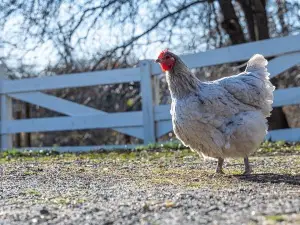
Rashes can affect anyone, they can develop because of allergens, insect bites, and allergic reactions, the same can be said for chicken rashes.
This article is a look into why there is a red rash on your chicken’s skin.
Table of Contents
Red rash on chickens skin:
If your bird has a red rash on its skin this is likely very uncomfortable and painful for the bird so dealing with the issue as quickly as possible is a must.
Here is why there may be a red rash on your chicken’s skin:
Dermatitis:
One reason why your bird may have a red rash on its skin is that the bird has contact dermatitis, this condition causes lesions to develop on the bird’s skin and may be the red rash that you’re seeing.
The lesions may be superficial and remain on the top layers of your bird’s skin or the lesions can develop into ulcers and extend deeper into the bird’s skin.
This develops in chickens whose skin is exposed to constant moisture mixed in with chemical irritants like ammonia from the bird’s litter.
The rash will usually develop on the bird’s hocks, feet, and breasts. You’ll be able to see the lesions on the bird’s body as early as 4 to 6 days of developing or 12 days of developing.
What to do:
If a bird has this condition there isn’t much you can do for the bird but you can prevent this from developing in other birds in the future.
Removing and replacing the litter in your hen houses is recommended.
If you need to reuse the litter that the birds are currently using then it is recommended that you dry the litter before the chickens can use it, you can do this by running fans during the day.
Parasite:
Another reason why your bird may be developing a red rash on its skin is that the bird may have some sort of parasite.
Your chicken may be scratching at its skin or picking at its skin because the skin is irritated and this may be causing the skin to look red and irritated, or look like a rash.
Your bird can become infected with a variety of parasites including lice, mites, ants, and straw mites.
These parasites will live in your bird’s environment and will feed on your bird’s blood once the birds come into the coop at night to sleep.
The bird’s legs, feet, vent, and breast are especially vulnerable as parasites love to feed in these areas.
What to do:
Figuring out what your bird is infected with is the first step to solving your bird’s problem.
Check the bird’s vent, and the other non-feathery parts of your bird, for parasites, and also check cracks and crevices in the bird’s house.
You can relieve some of the irritation on your bird’s body by applying a thin layer of an antiinflammatory cream where the rash is while you try to figure out what is going on.
If you find that your bird does have a parasitic infection then treat the bird using a permethrin-based poultry dust.
Permethrin-based poultry dust will not only kill parasites like lice and mites, but they will also get rid of mosquitoes, cockroaches, flies, fleas, and any ticks in your birdhouses.
The product will also kill any parasite eggs in your hen houses. You’d need to treat your chicken at the same time as you treat the hen houses.
If you enjoyed this article then you may also be interested in other bird related articles. Here are some articles that you may be interested in: Baby Chick Wants To Be Held All The Time, Baby Chick Looks Wet, White Spots On Cockatiel Beak, Baby Chick Screaming, Baby Chick Distress Call, Chicken Stuck On Back, Chickens With Red Skin, Baby Chick Laying Down With Wing Out, Baby Chick Won’t Walk Or Open Eyes?


